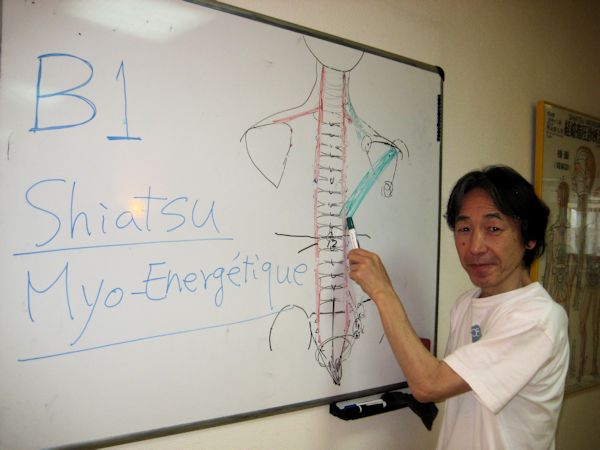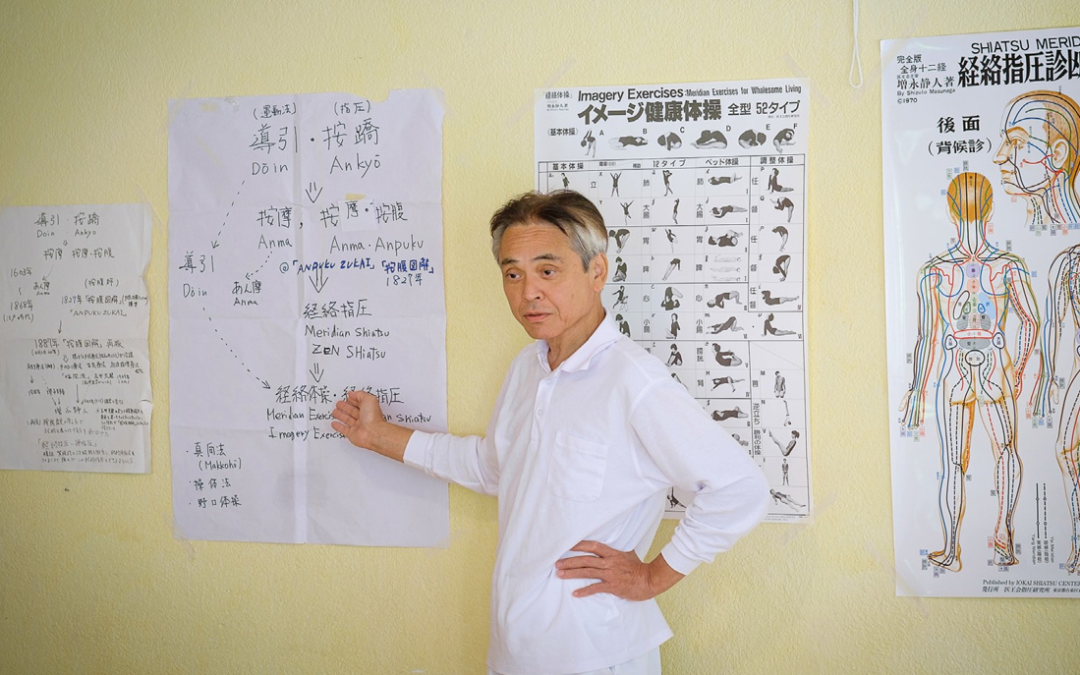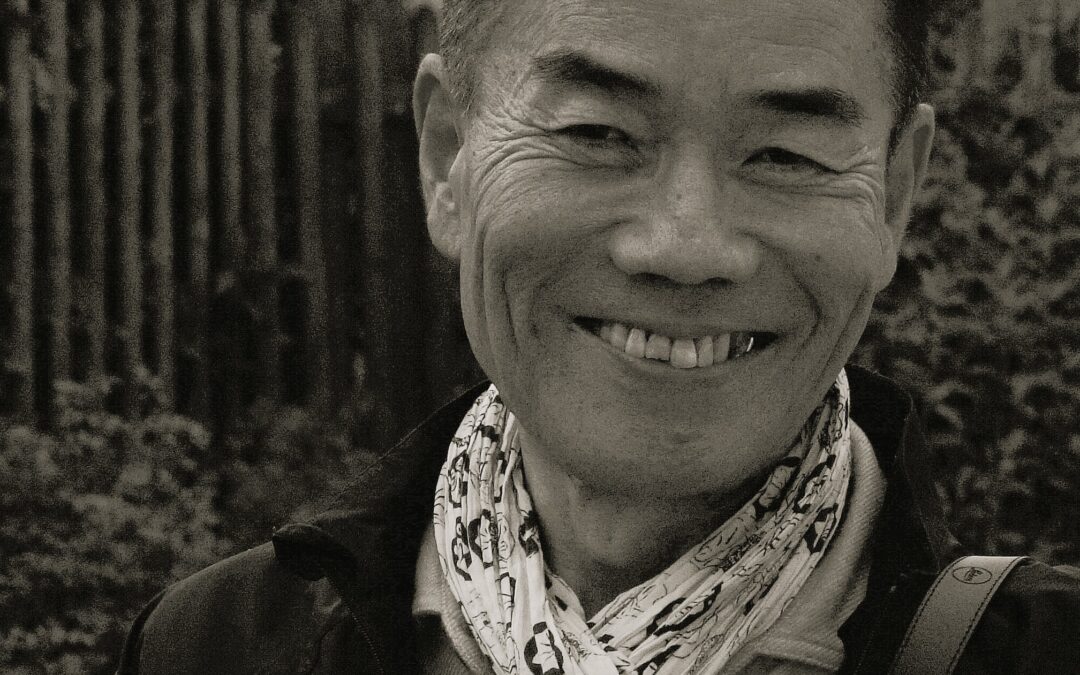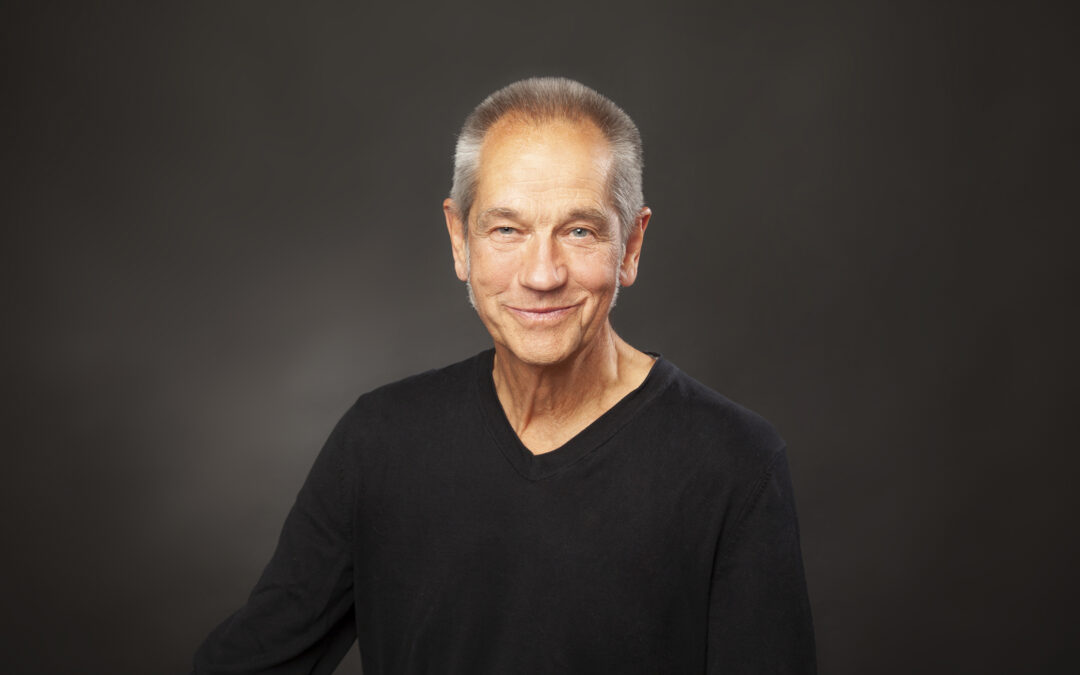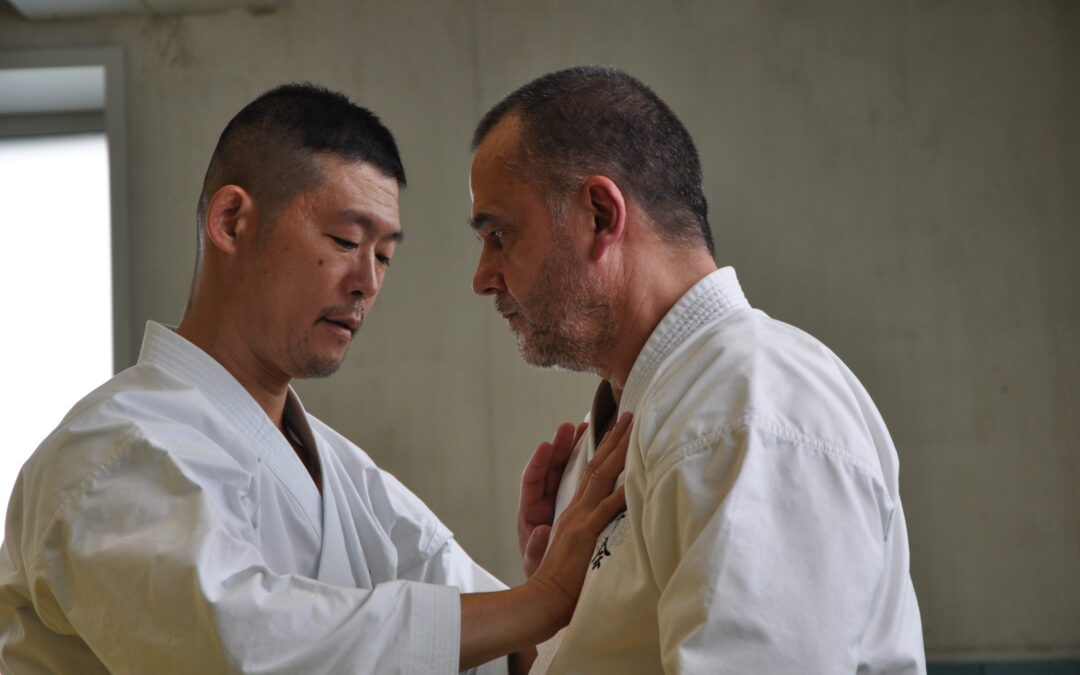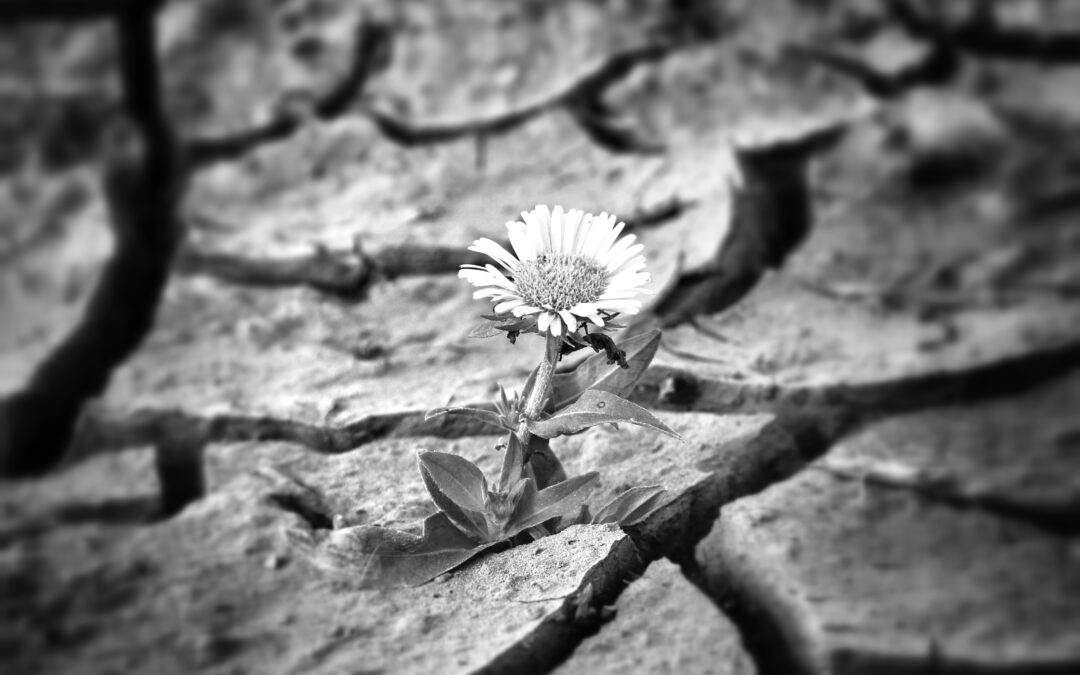Among the masters I meet from time to time, there are some who seem straight out of a manga by Jirō Taniguchi. Calm, smiling, quite humble, a quiet force emanates from him that nothing could shake. His delicate manners remind us of old Japan. Yet, his career was hectic and that is precisely from his past trials and his many passions that he draws his actual technique as broad as exciting: the myo-energetics. Let’s discover Hiroshi Iwaoka, a discreet master worth knowing.
Ivan Bel: Where are you from?
Hiroshi Iwaoka: I come from Japan. I was born in Yokohama in 1955. My father was a farmer.
When did you first come to France and with what purpose?
I first came to France in 1977 to learn French. I was 22 years old.
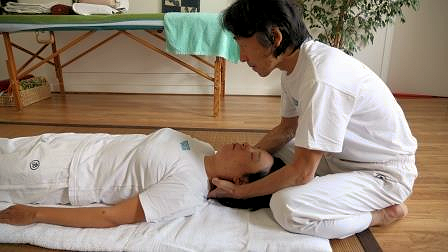
Hiroshi Hiwaoka doing shiatsu
When you went back to Japan, you discovered shiatsu in a sauna. Tell me how that happened?
I learned shiatsu before I went to live abroad. I failed the entry exam of the university I wanted to join. So I decided unwisely to go to England to learn English. I needed a lump sum of money to stay two years in England. In order to have enough savings I started working as a waiter in a sauna. There are always a few shiatsu practitioners working in saunas in Japan. They told me, “I teach you Shiatsu and you give me shiatsu back.” I was not eager to do it nevertheless that is how I learned shiatsu for a year.
It was 43 years ago and I was 20 years old then! A long time ago now (smile). I do not know what style of shiatsu it was. But for sure it was neither the Matsunaga’s shiatsu nor the current Namikoshi’s shiatsu. I remember that in the old days, good practitioners applied pressure on the tendino-muscular lines. I think the shiatsu I learned at the sauna was that old shiatsu applied on the tendino-muscular lines.
When I saved enough money, I left for England, then I lived in Australia, in France and in Canada, always with the aim to find something that could really bring passion in my life. But I did not find it. I then returned to Japan when I was 25 years old. Once there I worked in an art company for a year. Then I enrolled in an acupuncture school when I was 26 years old.
Was it difficult to work in the baths?
Not at all. I loved the sauna. After working as a waiter, I practiced and learned shiatsu directly on practitioners.
Then I started in the sauna. Every day was the same. I was rather happy with the work.
It’s interesting that you went from shiatsu to acupuncture. Why?
I thought that one day I would live in Europe. I thought, “I can practice shiatsu and if I could also practice acupuncture, I could settle more easily in Europe”. That is what I thought. So, I enrolled in an acupuncture school.
Your master was Sorimachi Senseï. Can you tell me how it was to train with him? What kind of a person was he?
My acupuncture master, Sorimachi Senseï, was a typically traditional man, with a “severe” attitude. But, his acupuncture treatment was amazing! Besides, he was so well known and respected that he treated the imperial family at that time. There was no training with him, at least not in the current sense. I went to his office with two classmates after attending a class at school. We watched his treatment for 5 hours, and after that, we did the housework. That’s what we did every day for three years. It was really a traditional approach, as in the martial arts.
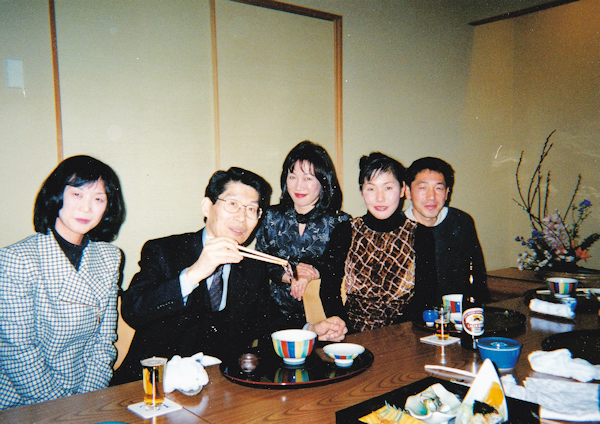
Hiroshi Iwaoka (on the right) with Sorimachi sensei (with chopsticks) in 1996, and others students.
Sorimachi Senseï was one of the first disciples of Dr. Keizo Hashimoto who developed the sōtaï in the 70s. It is Sorimachi Senseï who introduced the sōtaï for the first time in the United States. One day, shiatsu master Ohashi came to his office. He asked Sorimachi Sensei to do the sōtaï internship in New York. Sorimachi Senseï replied, “No“. I thought it was a shame. I asked Sorimachi Senseï why you said “No”. He told me: “because Mr. Ohashi is a business man.” I lost the opportunity to go there, to stay in a luxury hotel in New York with Sorimachi Senseï.
After Antibes, you came back to France, didn’t you?
Yes once I earned the State diploma of acupuncture and moxibustion, I went back to France in 1985. The city I chose was Nancy just because I had French friends who lived there. I wanted to settle as an acupuncture practitioner and also I wanted to make known the Sorimachi Sensei’s method in France.
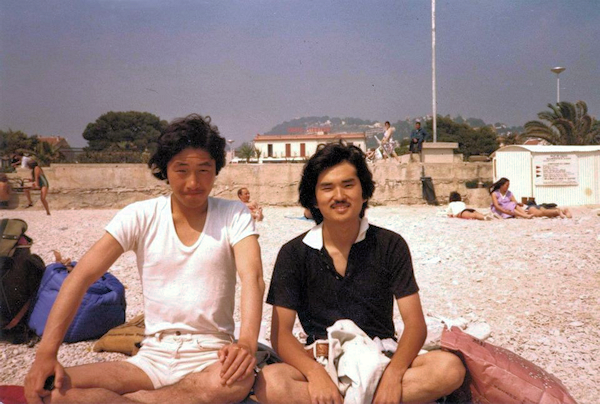
Hiroshi Iwaoka with his best friend, in June 78 in Antibes.
Did you manage to practice acupuncture? How did it go?
No, I could not achieve this project because according to French law you have to be a medicine graduate to treat patients by acupuncture. I liked this city but I could not do a thing there. It did not go so well. I returned to Japan nine months later with great disappointment. It was 33 years ago when I was 30 years old.
It must have been difficult for you to return to Japan. It was your second failure in France. What did you do once there?
I gave up my plan to live in Europe and I opened an acupuncture practice in Kamakura.
During the 15 years you spent in Kamakura, you continued to train to be a multi-skilled practitioner. Can you tell me what you have learned? And why these ceaseless studies? Did you meet other shiatsu masters?
My life in Kamakura was really great. I was surrounded by friends. I had time, money and besides I could travel. At that time I grew an interested in health and beauty. My curiosity brought me to the fields of aesthetics, makeup and cooking. I am the sixth Japanese to obtain the license of international aesthetics, CIDESCO. I temporarily left my office to go to Thailand to learn Thai massage and to Italy to study Dante’s language. As for shiatsu, I did not practice it during this period in Kamakura.
At last, the idea to live in France came back to haunt you.
I realized all my desires and my dreams while I lived in Kamakura. That’s when I remembered France.
My last experience in France had not been positive at all. That’s why I wanted to give it another shot to fully enjoy my life in the country. I told myself that I would regret it all my life if I did not do it. So I returned to Antibes in early 1999. I obtained a student visa. The reason I chose Antibes is that the weather is nice all year round and the city had a nice atmosphere. Moreover Antibes is not far from Italy and as I spoke Italian … (smile).
Did you speak French at that time?
Yes, but not very fluently.
The most amazing thing is that this time you come back with a project that has nothing to do with what you can do.
My idea was to open a small acupuncture practice. But first of all, I wanted to start an agricultural fertilizer business. Sorimachi Sensei had invented a new kind of fertilizer. We had already tried in Japan and it had greatly improved the taste of vegetables. Since I did not have the means to open my practice immediately and that I like wine, I thought to myself that it would be nice to be able to produce good bottles using these fertilizers. I wrote letters to about fifteen producers, offering them to improve the quality of the wine. Three of the most famous wineries in the world replied: “We want to give it a try.” From that day on I went back and forth between Antibes and Burgundy once a month to spread fertilizer in the corners of fields.
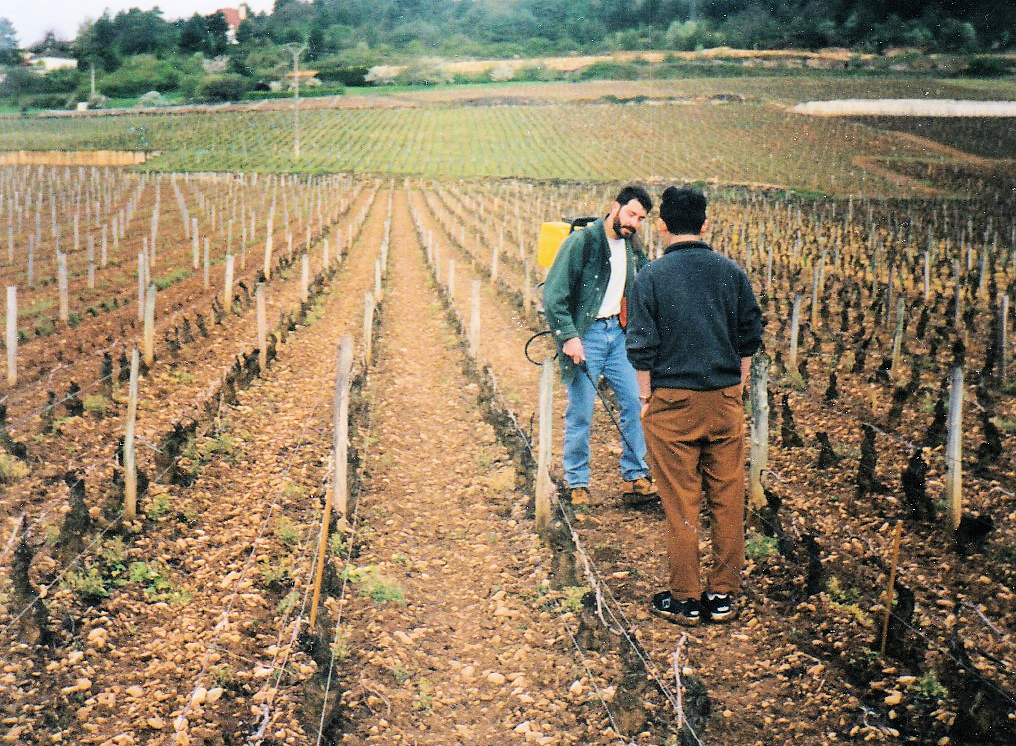
Hiroshi (from back) in the vineyard in Burgundy, 1999.
If it worked, not only could I drink as much good wine as I wanted, but I would have enough income to live in France. Six months later, the tasting day had finally arrived. In fact, we did not see much difference.
When comes to think of it, these producers already have a soil basically good, full of minerals. Besides, it is difficult to better what they do because their wines are already excellent.
So what did you do? Go back to acupuncture?
I withdrew from the winery activity and I opened an acupuncture practice in a flat based in a building where doctors and lawyers were already settled. But I only had three patients in three months. In addition, two of them were friends of friends (laughs). That is to say there was truly only one real patient so I closed my office.
Finally, it’s a job offer linked to shiatsu that came to you. Do you want to tell us about your adventures with the school you opened?
Yes, that’s when I received a new job offer. When I went to pay my rent to the real estate agency, an employee gave me the phone number of a man interested in shiatsu. I contacted him immediately. His name was Marc, and he said, “We are creating a school specialized in health and beauty, and we would like to ask you to teach.” I was very motivated by this proposal. A dozen specialists, such as a yoga teacher, a beautician, a massage therapist, a counselor, a dietician or a pharmacist were gathered at a first meeting. Everyone brought their ideas to bring forward the project but it did not last long. This school project was most interesting but the funding was not sufficient. People left one after the other. In the end, there was only me, Marc, his osteopath friend and a pharmacist. I stayed because I did not have any other work anyway. That’s how the school of health became the shiatsu school. I took care of internships and the other three took care of marketing and administration. The school finally opened in 2001. We opened the school, but we did not have any students.
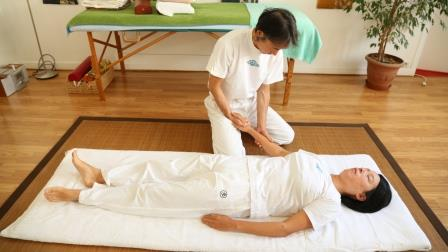
A school without students naturally has a consequence: no money. So I worked without pay for 4 years. At that time, I did not have a penny left in my pocket. So I went to work in Japan twice a year. I jumped on a plane, I earned the maximum money in a few weeks from my former patients and then I went back to Antibes.
Why didn’t you keep the word “shiatsu” but chose to create the name “myo-energetics”? What does this change of name mean to you?
In the myo-energetics training I teach several techniques such as shiatsu, sōtaï, micro puncture, direct moxas … to realize the theory of treatment. This means that myo-energetics is not a technique, but a set of techniques. Myo-energetics is a therapeutic method based on a theory that I discovered.
You met your wife Kikuno in the south of France. I really like this story because it was born of a misunderstanding. She thought you were a millionaire?
It is true! At first, Kikuno thought I was very rich. I must say that I lived in luxury housing. The living room alone was fifty square meters with a twenty square meters terrace. The house overlooked a huge garden where there was a swimming pool always filled with water. The place belonged to a wealthy person who wanted to have a trustworthy guardian during his absence and I had a moderate rent. She fell in love with the place, and finally, despite my precarious situation, we got married.
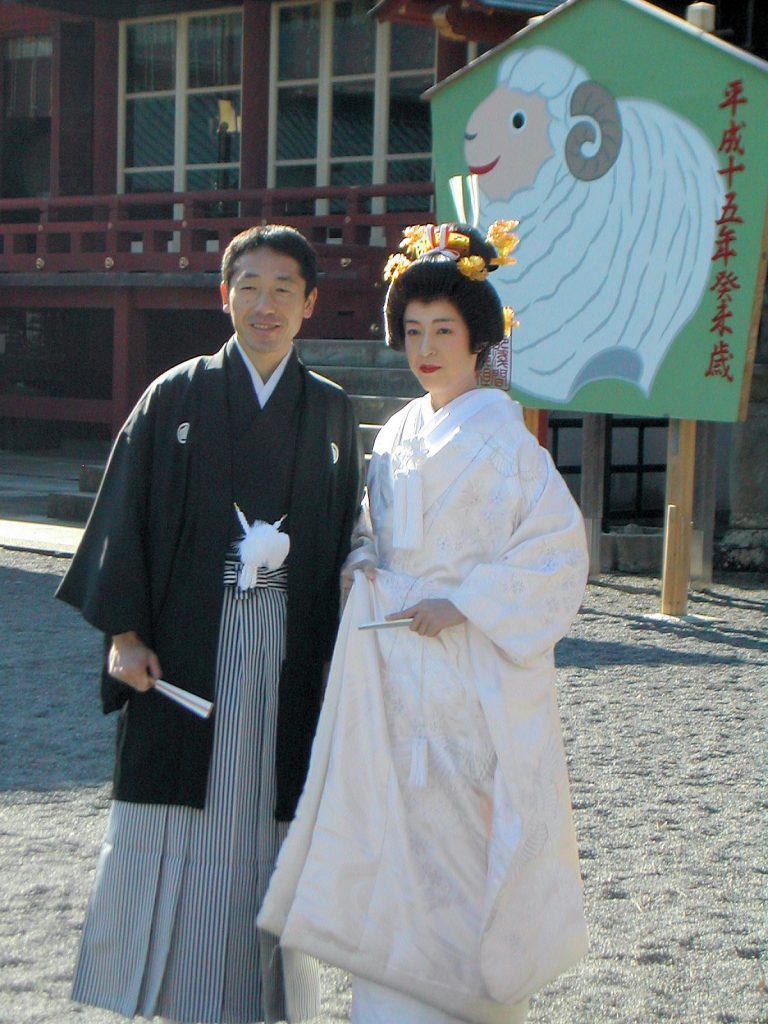
Hiroshi and Kikuno’s wedding in 2002.
Then comes the time when it does not go well with your associate. How did you bounce back again?
In the fourth year since the opening of the school, the number of students had finally increased considerably and I thought we did not need to worry about the management of the school anymore. But in reality, Marc and the pharmacist had contracted considerable debt in order to build a laboratory to make essential oils and perfume. All my earnings were for repayment. I really worked hard and I did my best to save the school but they had monopolized all the benefits.
When I resigned Marc threatened me with a letter, “Mr. Iwaoka’s inappropriate behavior has caused us to lose clients and we suffered damage”. Or “He invited one of his female students to the restaurant …” In that letter, there were unjustified accusations. It was clear that his goal was to prevent me from leaving the school. Since he acted this way, I filed a complaint against Marc and the school.
That is when you moved to Paris?
I did not have many opportunities to treat patients in Antibes. I thought the provincials were quite conservative and the idea of healing with acupuncture or shiatsu was not yet general practice. As a result I started thinking about opening a practice in Paris. That’s when I got a residency card for ten years. I also completed the book I had been working on for several years. I wanted to share my method of care in this book. So that is when I decided to leave the south of France and go to Paris. Kikuno was delighted to cut ties with Marc. It was in the summer of 2005.
How did you start in the French capital? Who helped you?
I started practicing therapy right away. A year later, I started teaching shiatsu at the headquarters of the French Federation of Traditional Shiatsu (FFST) in Paris.
Two years later, in 2007, my book entitled MYO-ENERGETICS was published by Guy Trédaniel.
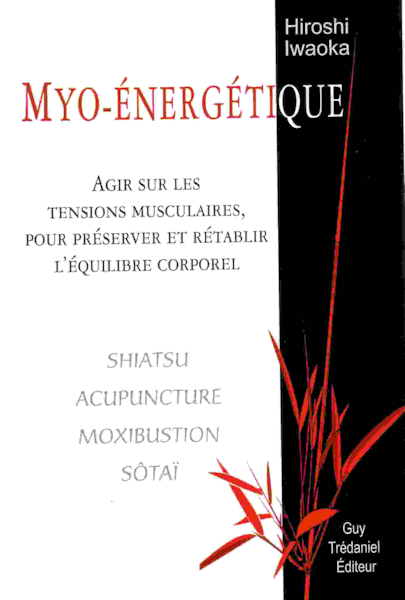
First book of Hiroshi Iwaoka, where he exposes his theory of myo-energetics.
As for the shiatsu training and the publication of the book, it was Claude Didier, founder of the FFST who helped me a lot. And then there is the Francophone Union of Professional in Therapeutics Shiatsu (UFPST).
It was Charles Gamet who invited me to the first meeting for the creation of the Union in 2012. This is when I met Bernard Bouheret. I remember that the conversation was totally related to Chinese medicine. And since I do not practice Chinese medicine at all, I said, “I will not enter in the Union”. Bernard then replied, “No problem. We accept other styles of shiatsu ” which is a nice proof of openness. That’s the way it works. So I joined the Administration Committee. I was in charge of foreign relations, especially with Japan.
Once launched, you write a second book, directly in French. How did you do it since French is not your native language? It must have been a mountain of work, right?
For the training courses, I had already written texts and prepared my speech in French. The accumulation of this work enabled me to write a book in French quite easily. What took time was to explain my new theories clearly enough.
What is your vision of Shiatsu, or rather myo-energetics?
To cure pains and diseases we must first find the causes and then remove the causes, it is that simple. Thus pains and diseases cure themselves. Everyone understands this logic. But in reality today’s medicine does not practice this logic. For example, “Hemorrhoids are varicose veins (dilated veins) that develop around the anus. Varicose veins occur because of poor blood circulation. They are caused by constipation, cold, pregnancy …” This is what is written in the medical dictionary. But in reality today’s medicine is doing a surgical operation instead of improving blood circulation to cure hemorrhoids. Where is the logic? Hemorrhoids can appear on the right or left side of the anal canal. If it is on the right for example, muscle contractures responsible for the poor blood circulation are found around the anus on the right side. These muscle contractures and the poor blood circulation on the right side are due to the deviation of the pelvis to the right. The myo-energetics corrects the deviation of the pelvis to the right by relaxing muscle tension in the right sacro-lumbar area. As a result, muscle contractures around the anus loosen and blood circulation improves which can immediately make hemorrhoids disappear on the right side.
This is one of the theories of myo-energetics. To practice this theory, we practice one or more techniques such as shiatsu, acupuncture, moxibustion, sōtaï, micro puncture, a massage with oil or golf ball … See, it’s very broad. Personally, I would like to make known myo-energetics theory in all areas of care and also to the general public. I will work another 20 years to realize this dream if it is necessary.
What do you think is a disease?
Most pains and diseases appear either to the right or to the left relative to the body axis which is the spine and pelvis. This means that most pains and diseases are closely related to body imbalance. For me, an illness is primarily a physical imbalance.
Can you describe in more details what sōtaï is?
In the 1970s, Dr. Keizo Hashimoto developed sōtaï. He stated that muscle tension and postural deformity are related to the cause of the disease. Excessive muscle tension causes postural deformity. Depending on the progression of the postural deformity, one will have pain forming, an organ dysfunctioning or a disease. This process is reversible. So, if we correct the deformed posture, health is recovered. To straighten the deformed posture, Dr. Hashimoto has found a system of movement on the human body: if the body moves towards the easy and pleasant direction, the body balances itself.
Thus he discovered an exercise which identifies the postural imbalances of the body. This exercise leads to muscle relaxation by harmonizing the breathing and the movements of the patient. That’s what we call sōtaï.
Could you explain the link with shiatsu? In what way is it complementary?
In Japan, many practitioners who practice shiatsu often add two or three sōtaï techniques. Sōtaï and Shiatsu induce muscle relaxation which can correct skeletal imbalance, so pains and diseases are cured.
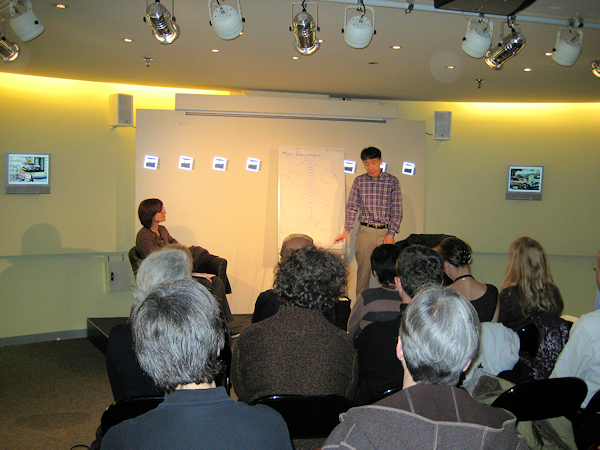
Conference in Nancy on the occasion of the release of his first book.
What are the similarities or the differences between these two techniques?
In Japanese, “指 shi” means fingers and “圧 atsu” means pressure. As the name “shiatsu” indicates, the practitioner applies a pressure with his fingers, especially his thumbs. “操 sô” means to lead, “体 taï” means body. As the name “sōtaï” indicates, the practitioner leads the body of the patient. Dr. Hashimoto said that “if the body moves towards an easy and enjoyable direction, the body balances.” So the practitioner leads the patient to move his body towards the easy and pleasant direction, therefore the patient’s body is balanced. It is the sōtaï.
The muscles are the support of the skeleton. The muscles make the skeleton move. So if the muscles become contracted, this muscle tension compresses or pulls the skeleton and causes a skeletal deformity, which also affects all the major physiological systems (breathing, blood system, lymphatic and digestive systems…). On the other hand, if the muscular tension is relaxed, the skeletal deformity is corrected and all goes back to working properly. Sōtaï and shiatsu induce muscle relaxation, which can restore skeletal balance, so pains and diseases are cured.
Do you teach sōtaï at the same time as shiatsu, or do you consider that these two techniques should remain separate?
For therapy, it is good to practice shiatsu with sōtaï for more efficiency. Both sets work perfectly.
Nowadays you have been teaching in Paris for many years. More and more students come to your courses. Do you not regret your bohemian years now that you are a well-established master?
It’s true that I lived like a bohemian, especially in Kamakura. I did everything I wanted to do at that time. Nowadays, I give internships besides the treatments in the office. When I have some free time, I write a book or prepare my speech for the internship. I think that as I lived freely in my early years, I now enjoy working all day and every day for the myo-energetics. Anyway, myo-energetics is the passion of my life.
When you look back at your life, what lesson do you take away from it?
What I learned from looking back at my life is that a bad experience can become a good experience. It’s good to always be positive. Also, things progress little by little in life. If you want to succeed, you have to be patient, constant and continue until you succeed. One can stop from time to time, but should never give up.
A big thank you for your time and kindness.
A big thank you to you too!
Interview: Ivan Bel
Translation: Odile Fayet
- Book review: “Another self” by Cindy Engel - 30 September 2024
- 24-26 October 2025: Master Class in Vienna (Austria) – Shiatsu and martial arts - 20 August 2024
- Lembrun Summer Intensive Course – July 6 to 12, 2025: Digestive System Disorders, Advanced Organ Anatomy, and Nutrition - 4 August 2024
- Anpuku Workshop with Ivan Bel in London – 7 & 8th, June 2025 - 22 June 2024
- Interview with Wilfried Rappenecker: a european vision for Shiatsu - 15 November 2023
- Interview : Manabu Watanabe, founder of Shyuyou Shiatsu - 30 October 2023
